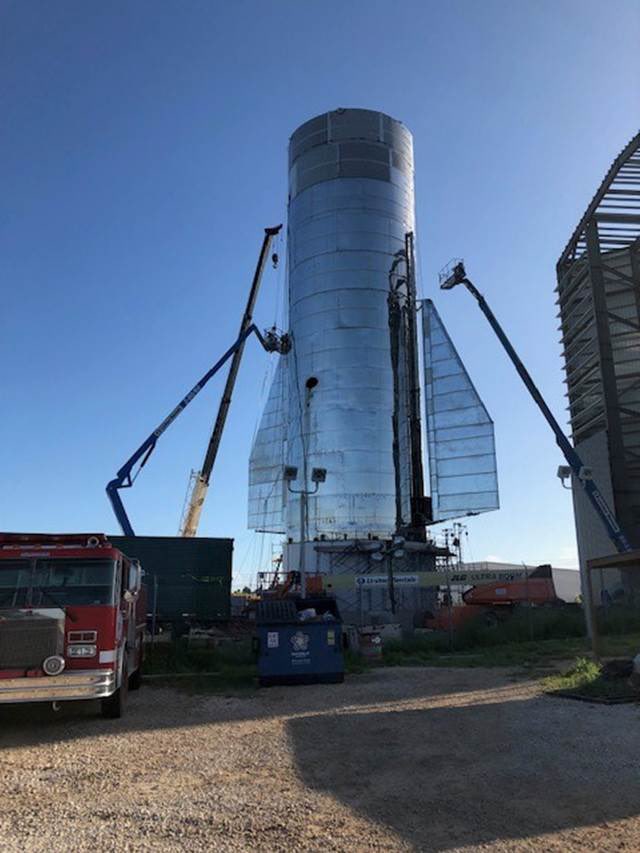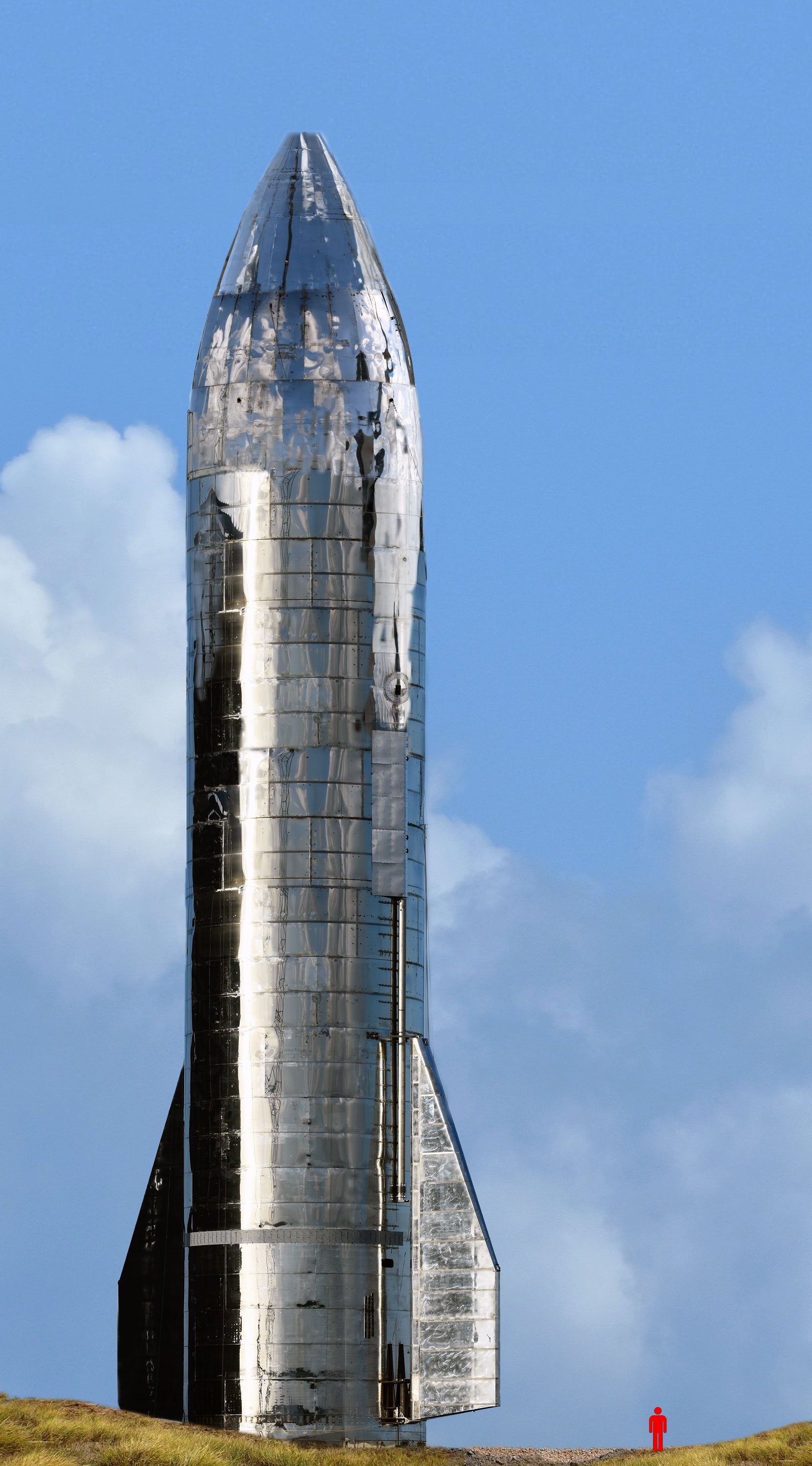Cool, it is all getting quite real. I had put this in the 'will happen in the 2020's not much to see in the mean time' category. So this is all bonus cool stuff for me.
Welcome to Tesla Motors Club
Discuss Tesla's Model S, Model 3, Model X, Model Y, Cybertruck, Roadster and More.
Register
Install the app
How to install the app on iOS
You can install our site as a web app on your iOS device by utilizing the Add to Home Screen feature in Safari. Please see this thread for more details on this.
Note: This feature may not be available in some browsers.
-
Want to remove ads? Register an account and login to see fewer ads, and become a Supporting Member to remove almost all ads.
You are using an out of date browser. It may not display this or other websites correctly.
You should upgrade or use an alternative browser.
You should upgrade or use an alternative browser.
Lots going on, and Elon sharing some details (number of fins, separate legs), and how hey is not “bought in” to that plan. Which feels odd at this stage. Check the thread here: Elon Musk on Twitter


Wow, Elon really revealed a lot about Starship control surfaces!

I would have said a skydiver in a wingsuit; realtime adjustable control surfaces!
We have three engines!
View attachment 458075
Check out the new sections at the foundary:
Bite my shiny metal assemblies.
Ack, misread the Tweet chain. That is just Boca, not foundry. The foundry is for Raptor engine, not rocket skins.
If you watch Elon’s most recent Starship presentation, from 2018, he shows a true physics simulation of the Starship entering the Martian atmosphere and then landing. There is a link to that presentation at the bottom of this page Making Life MultiplanetaryIs the idea to be more of a new Glenn-ish glider than a falcon 9-ish lawn dart?
That Mars landing didn't look glidery to me, other than the small climb at 2000 m/s near the end to scrub more velocity. It threw me for a minute, but the graph on the right is speed vs altitude, not he expected altitude vs distance.Got it--New Glenn glider-ey.
That Mars landing didn't look glidery to me, other than the small climb at 2000 m/s near the end to scrub more velocity. It threw me for a minute, but the graph on the right is speed vs altitude, not he expected altitude vs distance.
Semantics, perhaps, but it seems glider-ey in the way that a skydiver 'glides'...which is where I was going with this (trying to interpret Elon's "part skydiver"). "Over 99% of energy removed aerodynamically"
Semantics, perhaps, but it seems glider-ey in the way that a skydiver 'glides'...which is where I was going with this (trying to interpret Elon's "part skydiver"). "Over 99% of energy removed aerodynamically"
Ah. I was thinking glider as 'maximize horizontal displacement per unit of drop', whereas I would term skydivers as 'maximize time in free fall via surface area'. Starship looked more like 'burn off speed as fast as possible without melting' or sky divery with a huge initial forward velocity.
Now, if you are talking the high speed terrain hugging flying sky divers...
Monday updates here: Chris B - NSF on Twitter
And here: SpaceX Starship : Texas Prototype(s) Thread 2 : Photos and Updates

And here: SpaceX Starship : Texas Prototype(s) Thread 2 : Photos and Updates

And a neat photo-stitch of what this may look like in a bit: Mark Gerrits on Twitter
Note the little red human for size.

Note the little red human for size.

Is the idea to be more of a new Glenn-ish glider than a falcon 9-ish lawn dart?
You seem to have several misconceptions:
1. what we have seen so far is SpaceShip, which is a second stage, the equivalent in New Glenn is the expendable second stage which has no wings or control surfaces.
2. The first stage SuperHeavy is said to be like Falcon 9 by Elon. We haven't seen it yet, but probably no significant wings or control surfaces.
3. SpaceShip has four fins two at the nose and two at the tail and what seems like a stake connecting them. The fins and strake are drag surfaces, they don't glide or fly. Think of them as the arms and legs of a sky-diver, though the situation is not the same as they create drag from Mach 25 hypersonic down to roughly the speed of sound, while a sky-diver is strictly sub-sonic.
4. What we know of New Glenn first stage indicates that it probably generates most of its lift from the body, Falcon 9 also generates significant lift during 1st stage descent by body lift, although New Glenn will generate more lift.
I think everyone on this forum is aware that human skydivers operate at sub-sonic speeds.Think of them as the arms and legs of a sky-diver, though the situation is not the same as they create drag from Mach 25 hypersonic down to roughly the speed of sound, while a sky-diver is strictly sub-sonic
@bxr140 was making very rough analogies (comparing a returning F9 booster to a “lawn dart”) and I’m sure is well aware of the limitations of such analogies. And he was not referring to the Super Heavy stage.
Everyday Astronaut on Twitter
"Here’s how #starship controls pitch, roll and yaw (in that order in this clip) using just 4 total flaps. This is a unique form of control. I don’t know of any vehicle that does this with its control surfaces perpendicular to the airstream. Cool stuff @elonmusk. Full vid tomorrow!"
Elon: "That’s correct. Essentially controlled falling, like a skydiver."
Viv: "..but what's used to actuate the fins? Some kind of small motor?"
Elon: "Many powerful electric motors & batteries. Force required is enormous, as entire fin moves. More about this on the 28th."
Elon: "It does actually generate lift in hypersonic regime, which is important to limit peak heating"
Everyday Astronaut: "Pop back out of the dense atmosphere to radiate heat away and then drop back in awesome! ..."
Elon: "Better just to ride your max temp all the way down & let T^4 be your friend. Lower atmosphere cools you down real fast, so not crazy hot after landing."
Oran Maliphant: "Is “sweating” methane still an option?"
Elon: "Could do it, but we developed low cost reusable tiles that are much lighter than transpiration cooling & quite robust"
Scott Manley: "And just like that I need to rebuild some of my descent models. So the AoA won't be 90 degrees, it'll provide lift to keep vehicle out of denser atmosphere until it loses enough speed."
Elon: "Exactly. For reusable heatshield, minimize peak heating. For ablative/expendable, minimize total heat. Therefore reusable like Starship wants lift during high Mach reentry for lower peak, but higher total heat."
ShadowZone: "So this increases the probability of Starship having to do multiple aerobrake passes when going to Mars or returning, correct?"
Elon: "For sure more than one pass coming back to Earth. To Mars could maybe work single pass, but two passes probably wise."
"Here’s how #starship controls pitch, roll and yaw (in that order in this clip) using just 4 total flaps. This is a unique form of control. I don’t know of any vehicle that does this with its control surfaces perpendicular to the airstream. Cool stuff @elonmusk. Full vid tomorrow!"
Elon: "That’s correct. Essentially controlled falling, like a skydiver."
Viv: "..but what's used to actuate the fins? Some kind of small motor?"
Elon: "Many powerful electric motors & batteries. Force required is enormous, as entire fin moves. More about this on the 28th."
Elon: "It does actually generate lift in hypersonic regime, which is important to limit peak heating"
Everyday Astronaut: "Pop back out of the dense atmosphere to radiate heat away and then drop back in awesome! ..."
Elon: "Better just to ride your max temp all the way down & let T^4 be your friend. Lower atmosphere cools you down real fast, so not crazy hot after landing."
Oran Maliphant: "Is “sweating” methane still an option?"
Elon: "Could do it, but we developed low cost reusable tiles that are much lighter than transpiration cooling & quite robust"
Scott Manley: "And just like that I need to rebuild some of my descent models. So the AoA won't be 90 degrees, it'll provide lift to keep vehicle out of denser atmosphere until it loses enough speed."
Elon: "Exactly. For reusable heatshield, minimize peak heating. For ablative/expendable, minimize total heat. Therefore reusable like Starship wants lift during high Mach reentry for lower peak, but higher total heat."
ShadowZone: "So this increases the probability of Starship having to do multiple aerobrake passes when going to Mars or returning, correct?"
Elon: "For sure more than one pass coming back to Earth. To Mars could maybe work single pass, but two passes probably wise."
It appears that @bxr140 was correct:Semantics, perhaps, but it seems glider-ey in the way that a skydiver 'glides'...which is where I was going with this (trying to interpret Elon's "part skydiver"). "Over 99% of energy removed aerodynamically"
And Starship is also a lifting body:Elon: "...Essentially controlled falling, like a skydiver."
This was particularly interesting:Elon: "It does actually generate lift in hypersonic regime, which is important to limit peak heating"
ShadowZone: "So this increases the probability of Starship having to do multiple aerobrake passes when going to Mars or returning, correct?"
So in this case the term “passes” refers to the Starship descending partway into the atmosphere (Earth or Mars) to decrease speed, then ascend back to orbit, then descend again for landing when sufficient speed is lost?Elon: "For sure more than one pass coming back to Earth. To Mars could maybe work single pass, but two passes probably wise."
Similar threads
- Replies
- 143
- Views
- 5K
- Replies
- 667
- Views
- 31K
- Replies
- 4
- Views
- 503
- Replies
- 0
- Views
- 584
- Replies
- 43
- Views
- 7K



